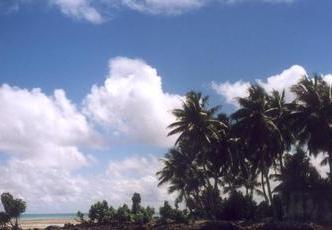 The small Pacific Island states are doing their best to keep the developed world aware of what is happening to them and other vulnerable states under the impacts of climate change.
The small Pacific Island states are doing their best to keep the developed world aware of what is happening to them and other vulnerable states under the impacts of climate change.
Kiribati this week hosted the second session of the Climate Vulnerable Forum, a forum initiated by the Republic of the Maldives in 2009 to bring together countries that were particularly susceptible to the adverse impacts of climate change.
Nineteen nations, both small island states and larger economies, attended this week’s Tarawa Conference and after what sounded like tough negotiation agreed on the Ambo Declaration, named after the village in Kiribati where parliament sits. It’s not a legally binding agreement, but is intended for presentation at the upcoming Cancun conference.
The text of the Declaration is on the climate change website of the Office of the President of Kiribati but in the meantime the news report provided there summarises it:
“The declaration covers the urgency of addressing the immediate effects of climate change, the need for fast funding to combat these concerns in vulnerable nations, and agrees upon an aim to make concrete decisions at the meeting in Mexico kicking off late this month.”
It doesn’t sound startling. Kiribati President, Anote Tong, said the meeting tried to focus on where delegates would find agreement “rather than fight and debate over our different positions”.
The Maldives Minister for Foreign Affairs, Ahmed Naseem, facilitated the meeting and spoke of the need to negotiate when a clause gives even marginal reference to a sensitive issue. He instanced the sensitivity of such questions as how emissions are limited and how they are monitored without infringing a country’s sovereignty.
One has to feel for the predicament of the vulnerable states. What they most need, and must strongly call for, is a legally binding international agreement which will drastically reduce greenhouse gas emissions. But they also need help from the countries most responsible for emissions to enable them to cope with the changes they have begun to experience and are set to get worse.
This double bind is reflected in the somewhat convoluted comments of President Tong to reporters at the conference:
Tong told reporters he was still pushing for a legally binding agreement treaty to promote long-term action to reduce greenhouse gas emissions – a bid that was snubbed at last year’s summit in Mexico in favour of the Copenhagen Accord.
However, he knows this is a big call and would settle on short-term solutions and dedicated funding boosts.
“It’s unrealistic to think that we can resolve these issues in a couple of sessions; it’s going to take the next few decades,” Tong said.
“There are certain issues which must not take that long.
“The longer we wait the more costly it’s going to be.”
But there was more to the conference than the Declaration. The President said in a Radio Australia interview before the conference opened:
“I think this will be the first opportunity for the large countries to actually see first hand what it is we have to contend with. To actually experience the high tides and the very marginal rise in elevation and land when the tide is coming in at the very highest level. And so this is an experience which not many people truly understand, and hopefully this will be an opportunity for, particularly the countries which are making the largest contributions to greenhouse gas emissions to truly appreciate what it is we are talking about.
“We continue to argue, vulnerable countries, about our survival. The developing countries, the large developed countries continue to argue about economic growth, the poverty and what have you. I think we must believe that there are common grounds, we must believe that there is a way forward.”
The interviewer noted that in Kiribati people are having to move further and further inland because of the inundation of water on their produce gardens. She asked how much further inland they can keep going before there’s nowhere else for them to go. Tong replied:
“Well that’s precisely the point, there is no inland for us. But I think this is also something that we want to demonstrate, that in some parts of the island you throw a stone and you actually hit the other side of the island. So there is no inland. And these are the issues and these are things that we want people to be able to appreciate.”
The interviewer asked whether this means there’s now is a need for more talk about environmental refugees, suggesting that what he’s saying is that the people on Kiribati will have to move eventually.
“I always make the point that I reject the notion of environmental refugees. I think what we want to be able to be prepared for is all possible eventualities, one of which may be the need to relocate our people. And in order to relocate we must begin to address these issues now, and part of the process of addressing them is referring for that process. And so it requires a very well planned and a long-term process. If we know it’s going to happen, we have the time to plan it, then there is no reason why we should not begin planning it now.”
That’s the ultimate in adaptation. But if we won’t listen to the call for no more than a 1.5 degree global temperature rise or 350 ppm carbon dioxide in the atmosphere, justice will demand that we at least enable such relocation as proves necessary.
Article by Bryan Walker
Bryan Walker is a Hamilton-based science writer and contributor to Hot Topic. View his work and that of 35 other scientists and science writers at Sciblogs, New Zealand’s largest science blogging network.




